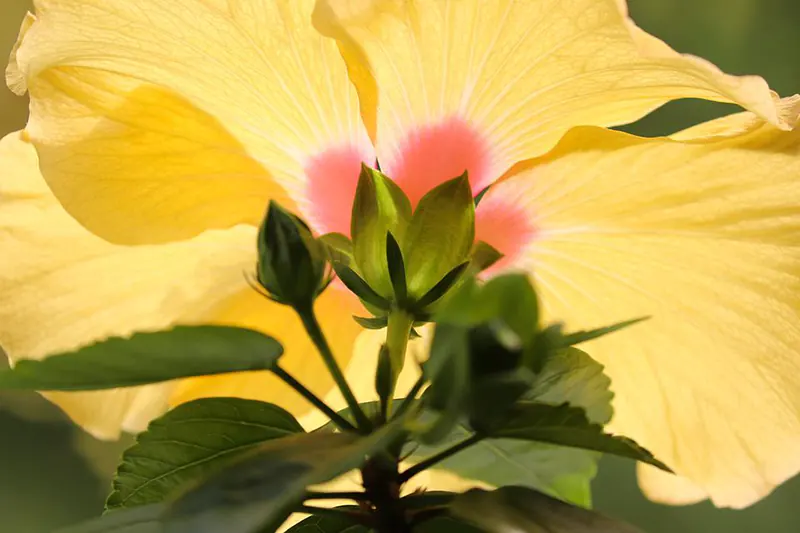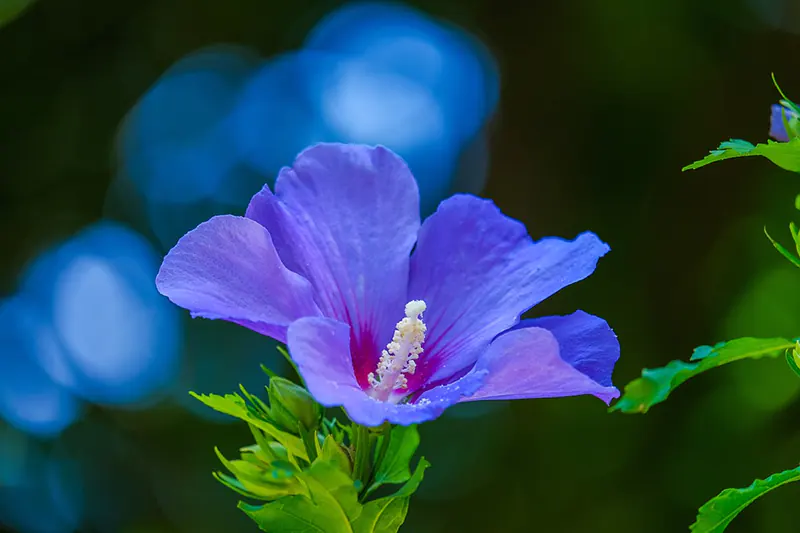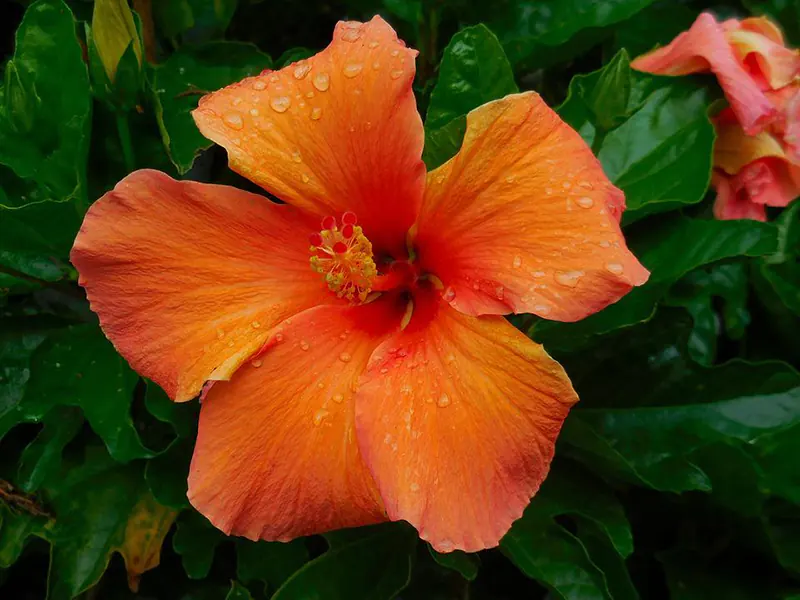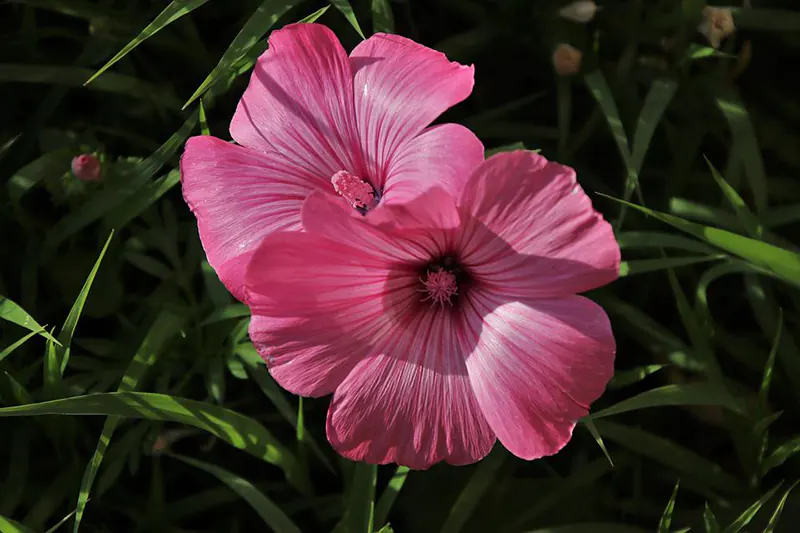How Do I Propagate Hibiscus in Water?
One of the easiest ways to propagate hibiscus cuttings is in water. These plants do well with water propagation, and, if done right, you should have new little plants to pot in around 4-5 weeks. Below, we’ll delve into the method I use most for propagating plants in water.
Even though this method may deviate slightly from others you may have read; this is what works best for my plants and warmer climate. You should, however, feel free to alter it if you need to so that it works better for you in your specific region.

How to Propagate Hibiscus in Water
Step 1: Harvest your Cuttings
The key to achieving successful propagation, regardless of your method, is to harvest the right cuttings. Any part of your hibiscus plant can technically be a cutting, but each part of the plant needs to be treated slightly differently, and some sections make for better cuttings than others.
For this propagation method, you’re ideally looking for sections of the plant that would be classified as hardwood but not fully mature. Hardwood tells you that you’re looking for stiff stems, preferably where the bark has developed. You don’t want to take cuttings from where your plant’s stems are still too green; this won’t fit the hardwood description.
You also don’t want to take hardwood stems that are too mature. Maturity, in a practical sense, typically means how much give there is before a branch snaps. You’re looking for branches that still give a little when you try to bend them.
A tip that is sometimes overlooked is that you should try and take your cuttings from branches that haven’t flowered yet. Flowering takes a lot of nutrients and energy, and once a branch has produced flowers, it’s unlikely to have the required potential energy to produce roots.

Step 2: Prepare your Cuttings
All you need for this step is your trusty garden shears, cleaned and dry, your cuttings, and a surface to work on. Your goal for this step is to clean the cuttings up, which constitutes getting them to the right length and removing unnecessary foliage. We do this because producing leaves takes energy as well. If your cutting has to use vital nutrients to support dense foliage, it’s unlikely to have enough energy to direct into rooting. Once the cutting roots, you’ll likely see the foliage return, but it doesn’t do the plant any harm to remove the foliage while waiting for the cutting to root.
The ideal length for cuttings is four to six inches. You’ll see this pretty much everywhere where anyone discusses cuttings. This doesn’t just apply to hibiscus either, this is just the general rule for the length of a cutting if you intend for it to root and thrive.
Cuttings that are too short don’t have much chance of rooting properly, and cuttings that exceed 6 inches aren’t likely to root sufficiently either. If your cutting is too long and does sprout roots, the resultant plant will likely look tall and lanky, and this is far from ideal for many gardening enthusiasts. No one is likely to reprimand you for making your cuttings too short or long, but the intent behind cuttings is to produce a plant that is predisposed to thriving, and irregularly sized cuttings aren’t likely to thrive. The bottom of your cutting needs to be cut at 45 degrees, and you should cut directly beneath a node in the stem.
Step 3: Scrape your Cutting
Not everyone regards this as an essential step in the process. Some people find that they have decent success without wounding the base of the cutting, but I find this to be a really effective way to ensure success when propagating cuttings of any kind, not just hibiscus. All you need for this step is a sharp knife, vegetable peeler, or any other sharp, clean blade. Your goal here is to run the blade down the lower inch of the cutting to expose the green flesh underneath the exterior bark. This is where the hibiscus cutting will sprout roots from. You don’t want to make your shavings too deep; you just want to lightly scrape off the outermost bark layer.

Step 4: Prepare your Water Propagation Medium
Here is where you may choose to deviate from this guide. The reason why I started investigating water propagation in my younger years of bonsai and horticulture enthusiasm is that I didn’t have the resources that conventional propagation methods require. I was looking for a way to propagate my favorite plants without having to use rooting hormone, special seedling and potting mixes, and other nutrients like peat moss.
In the beginning, my water propagation technique was to prepare my cuttings and simply shove them into a glass of water. Shove may be the wrong word to use here, but I exaggerate to prove a point; I didn’t want to have to do too much or go out and buy anything.
Now, however, the health and well-being of my plants are far more important to me than taking the easy way out. Therefore, I’ve found myself combining the traditional water propagation method and other methods together to create a sort of super water propagation regimen. For this, you’ll need a glass, water, potting mix, and rooting hormone.
All you need to do is put around two inches of water into a glass, and mix two tablespoons of potting mix and one tablespoon of your chosen rooting hormone into it. This is essentially a water propagation method that yields better root production results overall and usually promotes faster root growth.
If you don’t have rooting hormone, you can use honey or cinnamon powder in the water to promote faster and more successful root production.
That said, you can still use a plain glass of pure water for hibiscus water propagation.

Final Thoughts
Water propagation is an intensely easy method to use when propagating hibiscus plants. Propagation should usually be done during early spring so that you can plan your new little plants during summer. However, you can technically propagate hibiscus whenever you feel like it.
As long as your water container isn’t in a place where it is likely to freeze or boil, you can propagate hibiscus throughout the year. It’ll take a few weeks before you start to see any significant root growth, but don’t be discouraged. Unfortunately, not all of your cuttings will make it to the planting phase every time, but keep trying. You will eventually get the hang of water propagation and find the method that works best for you.
FAQs
Ideally, cuttings should be 4-6 inches long.
If your hibiscus cuttings are too short, they likely won’t root. If they’re too long, they have a smaller likelihood of rooting as well, and in the event they do root, the resultant plant may be too tall and lanky.
No. Rooting hormone promotes better root development and usually causes plants to root faster, but you don’t have to use it if you don’t want to.
Cinnamon and honey are good alternatives to the traditional rooting hormone. Another excellent option is apple cider vinegar. This should be used in absolute moderation though; one teaspoon of apple cider vinegar is enough for 5 cups of water. A few drops per propagation glass will suffice. Too much will inhibit rooting.
Rooting takes at least 3-4 weeks with most water propagation methods. Your plant may root sooner, but it could also take a little longer to develop adequate roots. Wait until your cutting’s roots are around 1-2 inches or longer before you plant them into pots.







